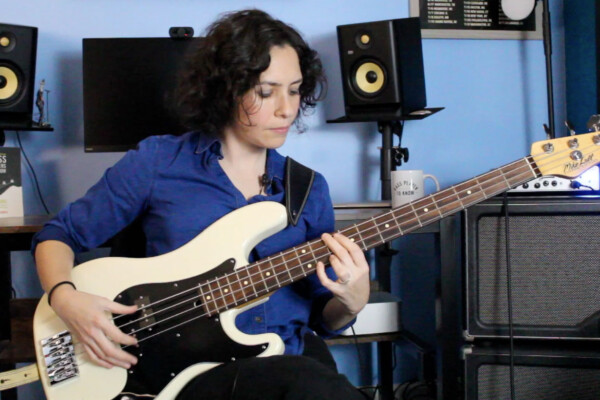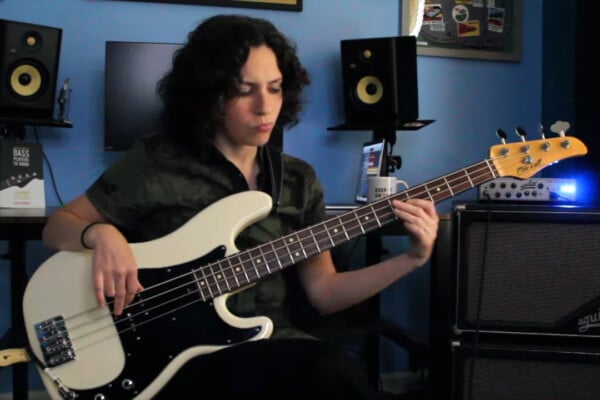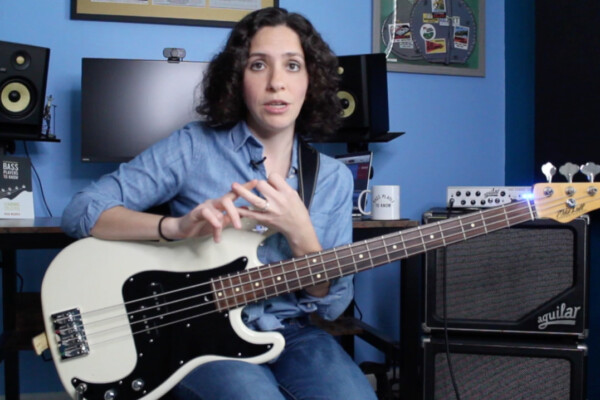Developing a Solo Over Chord Changes
Q: I have a question about improvising. If one browses the internet for learning how to improvise on the bass guitar, one can easily find lots of great tips: learn familiar melodies and expand them, learn solos from other instruments and be inspired by others. I would like to know about how to approach improvising using musical theory. In this respect you usually end up reading about chord tones and chord scales. This is a great, great way to start exploring improvisation (I have and love both your books!) I practice this often with iReal Pro, either with a jazz standard, or ii-V-I sequences across all keys. But here comes my problem: more often than not, I find it hard to actually build a nice solo. Using chord tones I find myself stringing together beautiful notes or short phrases once in a while, but without a single underlying harmony, my solo remains just that – some interesting notes or short phrases played back to back. The thing is, if the underlying harmony changes a lot, that is, when there are many chord changes in a row, this seems to prevent me from constructing a nice solo. I guess that’s the essence. How do you approach building a melody, using the knowledge of chord tones and scales, when the harmony changes all the time (which in a jazz standard it often does)? Even if I take it really slow, at 60bpm in iReal Pro, it often happens that the moment I’m ‘feeling it on a diminished chord’, a major seventh chord comes up, changing the harmony, and then my melody hits the fourth of that Maj7, completely destroying the mood and the melody. So, I end up either building a nice melody when the harmony doesn’t really change (e.g., as it lingers on a single chord for several bars), or if there are many different chords in a row, I play chord tones added with some appropriate scale notes or chromatic approaches, but without a clear structure to the improvisation; and this way, my improvisation sounds more like a walking bass pattern. Any help, tips, advice would be great!
A: Great question! It reminds me of a gig I was on about 10 years ago. It was my first time playing with Dan Balmer, who is a wonderful guitarist living here in Portland, OR. In between tunes, I asked if he would mind me taking some lessons at his house sometime when it was convenient. (This was pretty common for me. Anytime I had a gig with someone who impressed me, I was more than happy to pay them for a few hours and let me rapid fire questions, play and ask for constructive criticism, etc.)
Anyway, I asked for a lesson and he said, “of course. There’s a lot we will likely talk about but I can tell you one thing real quick, if you like”. Of course, I said, “of course”! His comment was this, “Your bass playing is solid. Great, in fact, but your solos are disjointed. It’s like you’re stringing sentences together that don’t relate. You’re improvisations as a conversation would sound like, ‘I want ice-cream. Chicago is far. Do you have a computer? My car is blue.’
After laughing for a solid few seconds, I said, “Yes! That’s exactly what I need to hear and now you have to set aside some time to help me work on that.”
I think, in essence, you are experiencing the same thing I did (and still do).
There is much that goes into a well-shaped and considered improvisation. Here are a few things to keep in mind while playing and then we’ll talk a bit about how to practice:
- Rhythm is as important as harmony (possibly more important) when it comes to the resolution of a line.
- If you want to have an arc to the solo as a whole, then you will have to begin your improvisation with restraint and molodicism. Save the chops for the peak! It’s fine to throw a few licks or quick transition lines in there early on, but don’t come out of the gate blasting away with everything that you’ve got. Use space and strong, consonant scale degrees in the beginning. Leave them wanting more so that, when you give more, it has the desired effect.
- The use of themes and motivic development goes a long way to connecting phrases. Starting with a melodic theme and then repeating, shifting and developing that theme is a very effective way of speaking in full paragraphs (as opposed to stringing sentences together and hoping they relate).
- Use the melody of the tune as your guide. The melody is the perfect collection of coherent ideas which relate to the song from which to draw from. Even grabbing one strong melodic statement from the melody can really help to adhere your ideas to that of the song and the development of an improvisation. You don’t have to play it note-for-note, but can rather take little ideas or snippets of the melody and take your time developing those and connecting them to your own melodic ideas.
Those are just a few things to keep in mind. The thing that seems to stump many of my students is connecting ideas through changes. Many developing improvisors find themselves starting a new idea with every chord change or tonal shift. You alluded to this in your question: you find yourself having ideas for one chord type but not being able to connect them effectively when a new tonality happens.
The connecting of chords is one of the most important things to work on when it comes to playing through changes (and not just from chord to chord). Each chord, no matter how seemingly disparate, is really a slight variation of the last. If you are having trouble connecting ideas through them, it is because you haven’t worked on the relationships between the chords.
If I stumble upon a chord type that gives me problems, I will set up a loop (if you’re using iReal Pro, you can simply make your own chord chart using nothing but that one chord. I’ll usually make a chart with one chord type, 8-bars per chord, moving through the cycle of 5th. Moving in minor 3rds can also be a nice challenge). I’ll usually loop the one chord until I feel like I’m beginning to “see” it on my fretboard and then play through the entire piece, moving through the cycle of 5ths (or minor 3rds…however I’ve set it up).
This is a wonderful way to acquaint yourself with that chord type but now it is time to put it in context and connect it to other chord types.
Setting up a loop of just 2 chords is a nice next step. You mentioned having issues moving from a diminished chord to a major chord because of the disconnect in tonality. That’s a great place to start! Set up a chord chart in iReal Pro (at a slow tempo!) of diminished chords resolving to major chords. They could move chromatically or in any way you like (but it helps if it makes sense harmonically). You can loop just two chords, or have the pattern continue to shift around the fretboard through different tonal centers. Whatever approach you take, move one step at a time. Don’t try and do too much, too soon. You’ll just confuse and frustrate yourself (take it from me!).
I will often practice trying to connect melodic concepts together, slowly, through changes. Here are some examples of what I work on: – play through a tune with 1 chord per bar – set the tempo to 40-60bpm – play 8th notes – try playing the full chord scale for each chord (ie: the scale appropriate for the chord, including any available extensions (#9, etc..) – now try playing the full chord scale in 3rds! (arpeggiating full chord scales. 1 3 5 7 9 11 13)
That will get your brain and fingers acquainted with the changes and insure that you know what notes are available to you.
Now, double the tempo and do the same exercise playing quarter notes. This forces you to continue the scalar (or arpeggiated) pattern through a chord change. You’ll have to shift some notes by a half step to keep them in line with the chord changes.
Do this for scales in 2nds as well as arpeggios in 3rds. Then, set the tune to a moderate tempo that is challenging but do-able.
Play a scale in 2nds starting from your lowest available note and continuing on through 2 or 3 octaves to a predetermined range of the instrument. Keep looping that ‘scale’ up and down the neck through the tune. Now you are taking one melodic pattern that you are very familiar with and altering it to suit the changes.
Do the same thing with 3rds, 6ths, whatever you can think of.
Next, experiment with this overall concept in your own way. Take a lick that you use and know well decide that you are going to play it over every chord (or every other) through a tune (short is best for now but you can extend things as you get comfortable doing this).
Alter the lick to fit the harmony so you start on the same scale degree as you normally would – now try it but change the scale degree so that you can keep the lick exactly the same every time and still fit the harmony (for example. If you have a minor lick that starts on the root of a minor chord, when you go to play it over a major chord you will have to start it on the 6th degree to keep it a minor lick over a major chord. If you are playing in a Dorian tonality, you would start the lick on the 5th degree to keep it attached to the relative minor).
These are just a few examples of ways you can explore taking what you know and moving it through changes effectively. This kind of practice will get your mind moving in the right direction and this approach will seep into other things you play and how you play through changes.
Now, let’s talk about rhythm. It can be helpful to really explore in more depth how rhythm effects resolution. I will often have students play entire choruses of a solo using rhythm only! Muted notes, plucks, muted thumps…it doesn’t matter how you get your rhythm as long as you eliminate harmony for a bit and try to phrase musically using rhythm only.
Then you can start to add harmony to the mix and move through changes. Use your imagination and combine rhythmic exercises to everything I’ve already mentioned.
For example:
- Decide on a rhythmic phrase (maybe a combination of 8th notes and 8th rests. Just keep it consistent and looping around on itself).
- Decide on a harmonic pattern (could be 2nds, it could be a grouping of notes moving in 2nds (1234, 2345, 3456, etc. Get creative here)
- Combine both of those constraints and play a few choruses through a tune before moving along and playing your own thing
It really comes down to you evaluating what it is that you really want to develop and then breaking it down into parts and really focusing on each little part of the whole. Even just focusing on this kind of work can change the way you approach things on stage and as the muscle memory develops (mental and physical muscle memory), it will slowly work it’s way into your natural approach to music.
I hope this helps!
Readers, if you have more questions regarding what I wrote here, feel free to ask in the comments and I will try to expand on this. Please add your own thoughts and suggestions as well.
Have a question for Damian Erskine? Send it to [email protected]. Check out Damian’s instructional books, Right Hand Drive and The Improviser’s Path.




Thank you!!! This is the best lesson I ever had in my life!!!!
Fantastic methodical shedding approach that addresses the question perfectly! Well done! I love this.
Thanks and very timely, I totally need work in that area too.
Many thanks Damian for this thorough explanation, this sure helps a lot!
Dang! Great lesson, Damian! Just picked up a 6 string and this lesson will see me spending a lot of time in the shed.
I’m a pianist/keyboardist and I think your approach is amazing for every instrumentists, thank you !